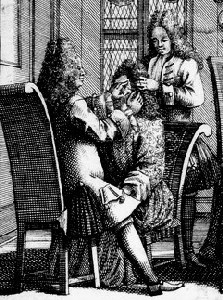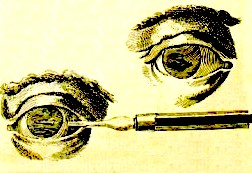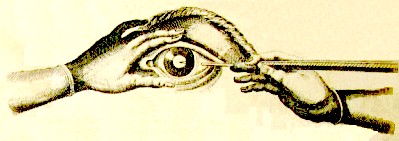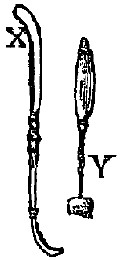
Eye Wounds and Surgery Page Menu: 1 2 3 4 5 Next>>
Eye Wounds and Surgery During the Golden Age of Piracy, Page 1
"[Pirate Captain Samuel] Burgess being of great use to them [an unnamed Dutch ship], they took him on board, and steered for a port, where some Dutch, taken in another ship, were marooned; but they were wrecked at

Eye Surgery Lorenz Heister (18th c.)
Youngoul, where Burgess continued 18 months. After this time was expired, he was desirous of leaving the place, and addressed himself to the king, who was uncle to the king of Methelage, he requested his black majesty to send him back to that port which he readily complied with, where Burgess continued almost five years, afflicted with sickness, in which he lost one eye." (Captain Charles Johnson, The History of the Pirates, p. 183)
When many people think of a pirate, one of the things that often appears in their imagination is an eye patch. Eye patches were used to cover some non-repairable damage to the eye - so they fell under health concerns - the area of ship's surgeon. Eye surgery was one of the many tasks that a ship's surgeon might be required to deal with in his duty to keep his charges healthy. This article will look at various forms of damage to the eye and how the ship's surgeon handled them.
We'll begin with a look at the sorts of eye damage that might occur in the daily life of a pirate or other sailor. Then we'll how one of the most common operations - removal of foreign objects from the eyes - was performed. Next we'll discuss different procedures a surgeon would perform for various non-destructive wounds of eye, followed by what was done for eyes that were beyond repair. Last we'll get to the interesting questions of the false eyes, the eye patch and their association with pirates in the popular culture.
Causes of Eye Wounds at Sea

Eye Surgery Detail, from A General System
of Surgery in Three Parts by Lorenz Heister,
Plate 17 (1750)
There are many different ways for eyes to be wounded. Ambroise Paré gives us a general view of what can
occur in the English translation of his masterwork, explaining that "Wounds of the eyes are made by the violence of things pricking, cutting, bruising, or otherwise loosing the continuity."1 This identifies several sources of
external damage that can occur. The French surgeon Pierre Dionis adds that "the Eyes are [also] afflicted with the most various and different Diseases. The Number is so large, that it exceeds an hundred... Of this Multitude there are but few which require the Chirurgeon's Labour; and 'tis with those that I am going to entertain you, and demonstrate the Operations proper to them."2
Curiously, while the two above land-based surgeons devote many pages to the treatment of wounds of the eye, our period sea surgeons do not provide us with many cases. One that is mentioned was caused by gunshot wound. Hugh Ryder tells us of a sailor who "was wounded in the Face with two slugs; one came in at his lower Jaw, beating in three of his Teeth, and a piece of the Mandible: the other having fractured the Os Jugale [one of the dermal bones below the eye socket], came through the Orbit of the Eye, not wounding it, but with the violence of the contusion leaving behind an incurable Amaurosis, or Gutta Serena [loss of vision]."3

A Sea Battle. Artist: Francis Swaine (mid 18th century)
The Capture of the Fourdroyant by HMS Monmouth
There is another example of a pirate whose eye was wounded by gunshot, noted in a newspaper account of his trial. As the account explains, he and his fellow pirates "were very much wounded, and no care taken in dressing, they were very offensive, and Stunk as they went along, particularly Lines [Philip Lyne], the Commander, who had one Eye shot out, which with part of his Nose hung down his Face..."4
Another form of eye wounding that jumps to mind is that made by flying splinters. When hit with large shot, wooden ships would frequently explode in a shower of splinters - something that might easily enter the eye. John Atkins, sea-surgeon, tells us how "Alexander Henderson, in that grand Naval Fight of ours with the French off Malaga, 1703. had his left Eye struck out by a Splinter, making that Side of the Os Nasi and Spongiosi [the bone on the left side above the nose] bare…"5
It is interesting that there aren't more splinter wounds to the eye mentioned in period sea-surgeon books, given the splinter wounds abound in other parts of the body. In his blog on pirate eye-patches, Jonathan Clayborn makes an interesting, if not entirely provable, point. "Most people use their hands and arms to shield their face in the case of flying debris, so injuries to the eye would have been somewhat mitigated by that action."6
1 Ambroise Paré, The Workes of That Famous Chirurgeon Ambroise Parey, p. 291; 2 Pierre Dionis, A course of chirurgical operations: demonstrated in the royal garden at Paris. 2nd ed., p. 290; 3 Hugh Ryder, Practical Observations in Surgery Containing Divers Remarkable Cases and Cures, p. 86; 4 The Evening Post (London), 28 May 1726 - Thanks to Ed Fox for providing this information; 5 John Atkins, The Navy Surgeon, p. 142; 6 Jonathan Clayborn, Atheneum Electronica: Dispelling Myths: The Pirate Eye Patch, gathered from the internet 6/1/2012
Removing Objects From The Eye

Eye Operation
from Lorenz Heister, A General System of Surgery in Three
Parts,
Plate 17, Page 416 (1750)
Perhaps the most readily apparent operation the surgeon performed on eyes is the removal of foreign objects. At sea, as on land, this included minor or major objects. Lorenz Heister identifies several things including "a Bit of Glass or Sand, a Splinter of Wood, or from off a Quill, or the Toe or Finger-Nails, and sometimes by little Insects, or caustic and pricking Bodies of various kinds, which, by slipping into this tender Organ, we daily experience".1
Pierre Dionis explains that the duty for removal falls to the surgeon "when the Patient has had all done to him that can, by rubbing and blowing into the Eye, the Pain which he feels forcing him to desire a speedy Help."2

Eye Instrument Detail
from Pierre Dionis,
A course of chirurgical
operations, Table XXXV
p. 299 (1733)
Each of the authors who address this problem suggest turning out the eye lid.3 Paré further recommends "turning up the eyelid with the end of a spatula."4 Dionis likewise explains that once the surgeon finds "the exotic Body, in order to force it out with the small Instrument X [seen in the drawing at right - the end on top appears to be a spatula.]"5
If that fails to work, Heister suggests making "a small Bath for the Eye, obliging the Patient to lie down, and pouring into the great Corner a little warm Water, which coming out, after having wash'd the Ball of the Eye, may draw along with it the Dirt or small Speck which occasion'd the Pain".6
Dionis agrees with the eye bath and then goes on to tell the reader that "if we cannot get it out this way, we fasten to a Sprig of Birch a small Bit of very fine Spunge Y, and sweep with it all the Fore-part of the Body of the Eye, in order with the Spunge securely to bring away whatever has got under the Eye-lids."7 (See Y in the drawing at right.) In a similar fashion, Heister recommends "dipping a Pencil-brush of soft Feathers, or a bit of fine Sponge fastened in a Quill, in warm Water, by which you may brush them out from betwixt the Eye and its Lid."8

Eye Object Removal Pincers, from The French Chirurgerye
by Jacques Guillemeau, p. 25 (1612)
Jacques Guillemeau, contemporary of Ambroise Paré gives us a detailed drawing of "certaine little pincers, which are very necessarye to voyde, & take away any fi[l]thines[s] out of the Eyes, or if the same cleave therein, where of the g, is like unto a little, smoothe, & playne Earepicker, to relevate the same out of the Eye: And f, demonstrateth a little pincer which is flat, & smoothe, to drawe anye thing therout, if so be it clefte therin, as a thorne, or some such like thinge. They are also very necessarye to plucke out the hayr of the Eyeliddes".9
1 Lorenz Heister, A General System of Surgery in Three Parts, p. 365; 2 Pierre Dionis, A course of chirurgical operations: demonstrated in the royal garden at Paris. 2nd ed., p. 326; 3 See Heister, p. 365, Dionis, p. 326 and Ambroise Paré, The Workes of That Famous Chirurgeon Ambroise Parey, p. 291; 4 Paré, Ibid.; 5 Dionis, p. 326; 6 Heister, p.365; 7 Dionis, p. 326; 8 Heister, p.365; 9 Jacques Guillemeau, The French Chirurgerie, p.24; 10 Heister, )bid.

